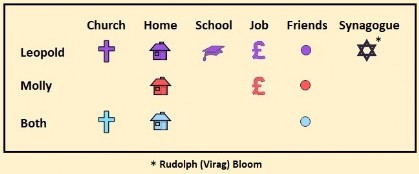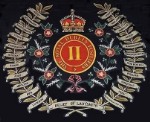Leopold & Molly in Dublin
This page provides a topographic look at the Dublin lives of Leopold Bloom and Marion (Molly) Tweedy individually and as a married couple. It covers their homes, churches, schools, and places of employment. Also shown are the residential locations of their friends, if such information is available from the novel.
Sources
Gunn, Ian and Clive Hart. James Joyce's Dublin. London: Thames & Hudson, 2004.
Haywar, Matthew Christopher. "Advertising and Dublin's Consumer Culture in James Joyce's Ulysses," PhD Thesis (Durham, UK, 2012).
Raleigh, John Henry. The Chronicle of Leopold and Molly Bloom. Berkeley: Univ. of Calif. Press, 1977.
Thom's Directory - 1883, 1904.
Irish Times, May 28, 1904.
Freeman's Journal, June 16, 1904.
Household Returns, Census of Ireland, 1901.
Locator Map

Bacon's Plan of Dublin, 1905 - New York Public Library

Download from Major Tweedy's Neighborhood
High resolution, detailed maps of Leopold and Molly in Dublin. The maps are in .pdf files stored on this website. To download a file, click on the document link. The document will open in a new browser window.
Northside: NorthSide.pdf, 2.9 MB.Southside - East: Southside-East.pdf, 3.3 MB.Southside - West: Southside-West.pdf, 2.5 MB.Suburbs - South: Suburb-South.pdf, 2.4 MB.Full Map: Full_Map.pdf, 2.9 MB.
The Topography of Joyce's Leopold and Molly Bloom
For more on the Dublin of Ulysses, see the following books, both of which are widely available in libraries and available, new and used, from online vendors.
Ian Gunn and Clive Hart, James Joyce's Dublin, Revised Edition (London: Thames & Hudson, 2004).
Frank Delaney, James Joyce's Odyssey: A Guide to the Dublin of Ulysses (New York: Holt, Rinehart, Winston, 1982).
Places of Worship
Church of the Parish of St. Nicholas Without and St. Luke: Here, at 108 The Coombe, Leopold Bloom was baptized into the Church of Ireland. Ulysses (Gabler) 17:540-43. At one time, the parish of St. Nicholas was divided by the city's ancient wall; one parish church was "within" the walls, the other "without." Back then, St. Nicholas Without did not have its own church and services were held in St. Patrick's Cathedral's north transept. In 1861, five years before Bloom's birth, the Church of Ireland amalgamated the parishes of St. Nicholas Without and St. Luke.
In Dublin folklore, this church and its locale both have a strong, long-enduring, but erroneous association with Dublin's Huguenot weavers of the late-seventeenth and early-eighteenth centuries. Joyce may have selected this place for Bloom's baptism for its perceived connection to weavers. In Homer's Odyssey, Penelope spent her days weaving a funeral shroud for her missing husband, Odysseus (known to ancient Romans as Ulysses).
n/ The Irish Church Directory, 1865, 1868; Thom’s Directory 1870.
Church of the Three Patrons: Here Leopold Bloom was baptized a Roman Catholic and married Marion Tweedy. Ulysses (Gabler) 17:545-46. This is also the church where Miss Tweedy attended mass and once confessed that a boy improperly touched her "... on the canal bank ..." Ulysses (Gabler) 18:107-08.
Hebroth Oakfield Place: This is likely the synagogue Leopold Bloom's father attended when as a widower, he returned to his old faith. At the time, the principal Dublin synagogue was on Mary's Abbey, off Capel Street just north of the Liffey. Rudolph would have been out of place there as the congregation consisted of fairly prosperous, native-born Dubliners with ancestors from England and Germany. Hebroth Oakfield Place was one of six small conventicles formed in the late-nineteenth century by Eastern European immigrants, primarily from Lithuania. It was established in 1885 at No. 1 Oakfield Place, relocated in 1896 to No.2, and then closed in the 1930s.
n/ Katherine Butler, "Synagogues of Old Dublin," Dublin Historical Record 27, no. 4 (September 1974): 118-30; The Jewish Yearbook (London: Greenberg), 1896/97, 1897/98.
Residences
Leopold Bloom was born at 52 Clanbrassil Street and lived there until he married Marion (Molly) Tweedy when he was age 23.
When Major Brian Tweedy and his daughter, Marion, arrived in Dublin from Gibraltar they first resided on Rehoboth Terrace in the middling southside neighborhood of Dolphin's Barns. Later, they moved to Brighton Square in upscale Rathgar. James Joyce was born 1882 at 41 Brighton Square.
Residences of Leopold and Molly Bloom:
Pleasants Street | Near to where Bloom grew up. | 1888 |
| Lombard Street, West | In "Little Jerusalem" where Bloom grew up. | 1888-1892 |
Raymond Terrace | Street is a section of the South Circular Road. | 1893 |
City Arms Hotel | Near the cattle market and slaughterhouse. | 1893-1894 |
Holles Street | Where the Bloom's were "on the rocks" in 1895. | 1895-1896 |
Ontario Terrace | A desirable location in Rathgar & Rathmines Township. | 1897-1902? |
7 Eccles Street | Bloomsday residence. | 1903- |
Schools
Leopold Bloom's first school was Miss Ellis's Infant School, a proprietary kindergarten. Ulysses (Gabler) 5:236-37. While in Ulysses there's no mention of Bloom's primary schooling, he most likely attended the nearby parochial school of his mother's parish. In 1871 Dublin, there was only one Church of Ireland administered, state school. Free sectarian schooling for children of Anglican parents; however, was provided by parish parochial schools which were often supported in part by the Church Education Society for Ireland, an Anglican charity. The Society also inspected schools it aided to ensure their pupils received adequate secular and religious teaching.
The premises of the Parochial School of St. Luke and St. Nicholas Without, two buildings and a playground, were at 20 New Street. That's about 800 meters from the Bloom family home at 52 Clanbrassil Street. As an endowed institution, the school was supervised by the Commissioners for Endowed Schools in Ireland. Note that in 1861, the separate schools of St. Luke and St. Nicholas merged. The 1857 inspection report of St. Luke's shows 119 enrolled pupils (30 boys, 24 girls, 65 infants); all attending free of charge. The inspector found instruction of the boys and girls unsatisfactory and the academic standing of the boys "very backward." That year's report for St. Nicholas Without shows 146 enrolled pupils (84 boys, 62 girls, no infants). Schooling was free except for a few pupils of the better-off families who were charged 4s. 4d. per year. The inspector found the school satisfactory in all respects. The combined school was examined in 1880. That year, all 338 enrolled pupils (86 boys, 84 girls, 168 infants) attended free of charge. Three pupils were Jewish; none Roman Catholic. The inspector considered the classrooms and playground "good" and determined the buildings were "in perfect repair." He found no fault with the teaching program. The curriculum was reading, writing, arithmetic, grammar, and geography. Also taught were scripture and church catechism, and for girls, needlework. Twenty-three years earlier, the curriculum included geometry and bookkeeping but by 1880, those subjects had been dropped.
After seven or eight years of primary schooling, Bloom entered The High School Dublin, 40 Harcourt Street. Most likely he was one of the needy students for whom fees were waived. Note that in Ireland, state-provided, free secondary education began in 1966, almost 90 years after Bloom entered the High School. Bloom attended that school for at least one year; two at most. It was at the High School that Leopold befriended Owen Goldberg and Percy Apjohn.
n/ Census of Ireland, 1871; Evidence, Report of the Commissioners for Endowed Schools (Ireland), Vol. 3, 1857-58, [2336-IV], at 76-77, 80-81, 118-19; Report of the Commissioners for Endowed Schools (Ireland), Vol. 1, 1881, [C. 2831], at 107, 364-67, qq. 8472-8565.
Places of Employment
D. Kellett's Dry Goods | 19-21A Great George's St. South | Shipping Clerk | 1882-1885? |
| Outside Sales | Door-to-Door Salesman | 1886 | |
Valentine Dillon Law Firm | 7 Rutland Square East | Bookkeeper | 1887-1888 |
Wisdom Hely's Stationery & Printing | 27-30 Dame Street | Clerk | 1888-1892 |
"On the rocks at Holles Street" | 1892-1893 | ||
Joseph Cuffe Cattle, Grain, & Wool | 5 Smithfield Street and The Cattle Market | Bookkeeper | 1893-1894 |
Wisdom Hely's Stationery & Printing | 27-30 Dame Street | Bill Collector | 1894-1895 |
David Drimmie Insurance Agency | 41 Sackville St. Lower | Clerk | 1896-1903 |
| Freeman's Journal, Ltd. Newspaper Publisher | 4-8 Prince's St. North and 83 Abbey St. Middle | Ad Salesman | 1903-1904 |
In 1895, Leopold Bloom was out of work and the family was "on the Rocks." Molly, at the time, had a part-time job at the Dublin Temperance Institute, Coffee Booths, and Restaurant, 6 Townsend Street, known as the "Coffee Palace." She sang and played piano there on Saturdays. Ulysses (Gabler) 11:485-87. On the ground floor there was a coffee bar and restaurant, on the next floor a library, billiards room, and meeting room, and on the top floor bedrooms for young men. Adjacent was a concert hall. The Coffee Palace was opened in 1875 by the Incorporated Dublin Total Abstinence Society.
n/ Dictionary of Dublin (1908), s.v. "Coffee Palace."
Their Friends
The following friends of Leopold, Molly, or both have addresses shown in the novel, Thom's Directory, 1904, or the Census of Ireland, 1901.
| Name | Residence | |
Rosenberg | Jewish friends when living on Lombard Street. | 63 Lombard Street, West |
Mastiansky | " | 16 St. Kevin's Parade |
Abramovitz | " | St. Kevin's Parade |
Goldwater | " | 77 Lombard Street, West |
Citron | " | St. Kevin's Parade |
Moisel | " | 20 Arbutus Place |
Watchman | " | 39 Lombard Street, West |
| Josie (Powell) Breen | Marion was suspicious of her and Leopold. | 12 Stamer Street |
| Richie Goulding | Stephen's uncle; primarily Leopold's friend. | Strasburg Terrace |
| Luke Doyle | Carmac Place | |
| Mat Dillon | Brother of Bloom's employer, 1887-1888. | Terenure |
[ You are at www.majortweedy.com>Characters>Leopold & Molly, Dublin ]
